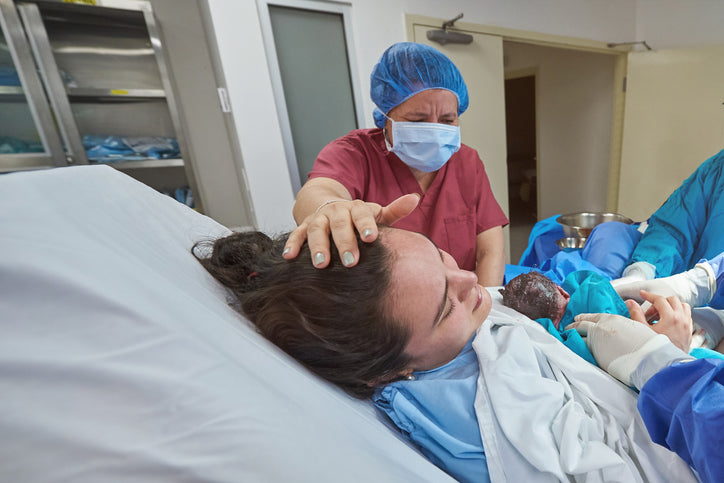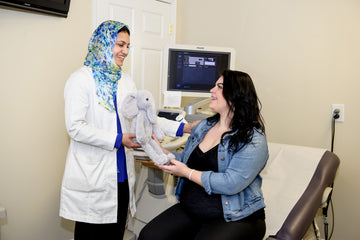Medical Interventions and Birth Outcomes: Be Educated.

Our society has predetermined pregnancy to be a game of dominos, all the pieces already lined up. It is more often than not that the game is set into motion at some point, typically labor, and if the pieces cannot be stopped, the game ends in a traumatic birth experience.
While your birth may not be traumatic, or end in a c-section, it has been found that one medical intervention tends to lead to another. No matter how you feel about your experience, know that this is not ok.
Labor should not be intervened with – it is meant to be handled just as the woman’s body handles it.
Statistically speaking, a low risk pregnancy has a higher chance of ending differently than expected if even one intervention is allowed. There has been an unfortunate shift in attitudes about pregnancy and birth, taking it from a natural life phase and turning it into a medical condition that needs to be "treated."
What exactly is an intervention?
Lying on your back is technically an intervention, as it interferes with your labor. That’s right. An intervention is something that goes against what would naturally be occurring.
That’s right. An intervention is something that goes against what would naturally be occurring.
- Inducing Labor
- Having a cervical check
- Scraping the membranes
- Breaking the bag of water
- Pitocin
- Laughing Gas
- Epidural
- Episiotomy (Cutting the woman’s vagina in labor)
- Vacuum Extraction
- Internal Fetal Monitoring
- Elective C-Section, Repeat C-Section
- Separation of mother and newborn
In the past 40 years, our cesarean rate has skyrocketed. In 1965 the rate was less than 5%, today it is over 32% – approximately one in three women will have a cesarean, most of those are unnecessary.
According to the World Health Organization, no country is justified in having a cesarean rate greater than 10 -15%. The United States’ rate is so high that even The American College of Obstetricians and Gynecologists admits it is worrisome.
According to Childbirth Connection, the risks to mothers from cesarean section include:
- Cesarean sections increase the mother’s risk for hemorrhage (severe bleeding);
- Cesarean sections increase the mother’s risk for blood clots;
- Cesarean sections increase the mother’s risk for bowel obstruction;
- Cesarean sections increase the mother’s risk for longer-lasting and more severe pain;
- Cesarean sections increase the mother’s risk for infection;
- Because of scarring and adhesion tissue, cesarean sections increase the mother’s risk for ongoing pelvic pain;
- Because of scarring and adhesion tissue, cesarean sections increase the mother’s risk for twisted bowel;
- Cesarean sections increase the mother’s risk for a longer hospital stay;
- Cesarean sections increase the mother’s risk for re-hospitalization;
- Cesarean sections increase the mother’s risk for poorer overall mental health;
- Cesarean sections increase the mother’s risk for depression;
- Cesarean sections increase the mother’s risk for psychological trauma;
- Cesarean sections increase the mother’s risk for rating her birth experience poorer than a mother who had a vaginal birth;
- Because cesarean sections usually result in a mother having “less early contact with her baby,” she is also “more likely to have initial negative feelings about her baby”;
- Cesarean sections increase the mother’s risk for future ectopic pregnancies;
- Cesarean sections increase the mother’s risk for reduced fertility;
- Cesarean sections increase the mother’s risk for maternal death at birth;
- Cesarean sections increase the mother’s risk for serious problems with the placenta in future pregnancies (placenta previa, placenta accreta, and placental abruption);
- Cesarean sections increase the mother’s risk for an emergency hysterectomy;
- Cesarean sections increase the mother’s risk for stroke;
- Cesarean sections increase the mother’s risk for a ruptured uterus in future pregnancies
- Risks to Newborns from Birth by Cesarean Section
- Because cesarean sections pose challenges in forming a breastfeeding relationship, babies born by cesarean section are less likely to breastfeed and to get all of the benefits of breastfeeding;
- Babies born by cesarean are more likely to be cut (during surgery);
- Babies born by cesarean are more likely to have breathing difficulties at birth;
- Babies born by cesarean are more likely to have asthma during childhood;
- Babies in future pregnancies are more likely to be born too early;
- Babies in future pregnancies are more likely to have low birth weight;
- Babies in future pregnancies are more likely to have a physical abnormality or injury to their brain;
- Babies in future pregnancies are more likely to have a physical abnormality or injury to their spinal cord;
- Babies in future pregnancies are more likely to die shortly after birth
- Why are the rates of C-Sections rising?
- low access to supportive care during pregnancy and labor
- ignorance of the dangers associated with cesareans
- an increase in other unnecessary medical interventions (aka the domino effect of interventions).
How to Avoid Interventions
- Support: Choose to be surrounded by a supportive birth team. Use a doctor who supports VBACs, vaginal births, unmedicated births, and births with hands-off approach. Select a midwife practice and hire a doula to be a part of the pregnancy and birth experience. Share your wants with your family and help educate them in your reasons so they feel confident in supporting you.
- Education: Take a couples-based natural birthing class. Understanding the birth process and the body will help you achieve the birth you desire – and avoid the unneeded interventions.
- Confidence: Because you are educated, you can be confident in your decisions made during labor.
- Ask questions, weigh risks and rewards with each decision, ask for options, buy yourself time to discuss, change positions, and practice relaxation….







